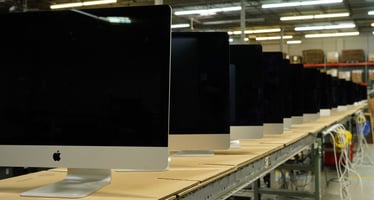In today’s hybrid-first world, the risk of losing IT assets during offboarding is higher than ever....
The Hidden Struggle of Remote Work: How ITAD Providers Help Enterprises Reclaim Employee Devices
When we talk about the remote work revolution, we often focus on the big, flashy shifts: flexible schedules, hybrid office models, the rise of digital nomads. But there’s a practical, messy side to this transformation that rarely makes headlines — what happens to all the company-owned laptops, monitors, phones, and other devices when an employee leaves?
As enterprises expand globally and workforces become more distributed, a growing number of companies are discovering that recovering devices from remote employees has become one of their biggest operational headaches. And here’s the surprising part: it’s not just about logistics — it’s about security, sustainability, and smart business.
Let’s break down why this challenge is growing and how specialized partners like IT asset disposition (ITAD) providers are becoming the quiet heroes of the remote work era.
Why Are Enterprises Struggling to Get Devices Back?
Think about it: five years ago, most employees worked in an office. If they left, they handed in their badge, laptop, and phone before walking out the door.
Today? That same employee might be working from a home office 1,000 miles away, in another country, or on a hybrid schedule. Multiply that by hundreds or thousands of employees, and you quickly end up with a giant hardware puzzle.
Companies are wrestling with:
-
Tracking who has what — especially across teams, contractors, and global offices.
-
Coordinating device returns — how do you arrange pickup or shipping, and who pays?
-
Securing sensitive data — how do you guarantee company information is wiped or destroyed?
-
Meeting sustainability promises — how do you ensure devices don’t end up as e-waste?
Many IT leaders I speak with describe this as a “wild west” problem they didn’t see coming — and one that’s now front and center as companies navigate layoffs, mergers, and workforce shifts.
The Hidden Risks: It’s Not Just About Lost Equipment
At first glance, you might think, well, how bad can it be to lose a laptop or two? But the stakes are surprisingly high.
For one, data security is on the line. Unreturned devices can hold sensitive customer data, intellectual property, or login credentials. In a world of escalating cyberattacks and strict privacy regulations, a single misplaced laptop could create massive financial and reputational damage.
Then there’s the sustainability piece. Investors, customers, and employees increasingly expect companies to back up their ESG (environmental, social, and governance) goals with action, and responsibly managing electronic waste is a key part of that. Letting unused devices pile up in closets (or worse, go to landfills) undermines those commitments.
Finally, there’s money on the table. Many retired devices still hold value — they can be refurbished, resold, or recycled for parts. But without a system in place, companies miss out on that recovery potential.
Enter ITAD Providers: The Bridge Between Chaos and Control
This is where ITAD providers like Synetic come in and why they’ve become essential partners for forward-thinking enterprises.
At a basic level, ITAD (IT asset disposition) providers help companies securely retire old technology. But today’s leading ITAD firms have evolved far beyond the “tech recyclers” of the past.
They now offer full-service solutions that make hardware recovery painless, even across remote teams.
For example, Synetic helps companies:
-
Arrange home pickups or pre-paid shipping kits for employee devices.
-
Provide certified data wiping or destruction with full chain-of-custody reporting.
-
Handle refurbishment, resale, or recycling, helping companies meet sustainability and profitability goals.
-
Deliver real-time dashboards and reporting, so IT and finance leaders know exactly what’s been recovered, where it went, and what value was recovered.
It’s about more than just disposal; it’s about turning a liability into an asset.
Making ITAD Part of the Bigger Picture
Perhaps the most exciting shift we’re seeing is the move toward ITAD-as-a-Service — a model where IT asset recovery isn’t an occasional project but a continuous, integrated part of enterprise operations.
Instead of waiting for problems to pile up, companies are embedding ITAD into their HR and IT systems. That means when an employee offboards, an automatic trigger goes out: a pickup is scheduled, the asset is logged, the data is wiped, and the sustainability report updates in the dashboard. No last-minute scrambling, no blind spots.
For companies managing large, distributed workforces, this is a game-changer.
Final Thoughts: A Modern Challenge Needs a Modern Solution
Remote work has reshaped the way we collaborate, innovate, and connect — but it’s also created new, behind-the-scenes challenges.
Device recovery is one of those challenges, and it’s not going away anytime soon. Left unmanaged, it exposes companies to security risks, sustainability failures, and financial losses. But with the right ITAD partner, it becomes an opportunity: to protect data, reduce waste, recover value, and run smarter, more responsible operations.
About Synetic
Synetic is a leading IT asset disposition (ITAD) provider helping enterprises navigate the complexities of hardware recovery in the modern workplace. With solutions that cover secure device pickup, certified data destruction, global logistics, refurbishment, resale, and recycling, Synetic helps companies turn IT asset challenges into measurable business, security, and sustainability wins. Whether supporting Fortune 500 firms or scaling startups, Synetic is committed to making ITAD simple, secure, and aligned with the needs of today’s distributed enterprise.
-min.jpg?width=50&name=Todd%20Leach%20(Default%20-%20Output%202)-min.jpg)




-min.jpg?width=50&name=Ron%20Helmer%20(Default%20-%20Output%202)-min.jpg)